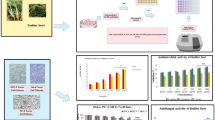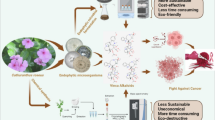Abstract
In course of a screening for small molecules presenting potential anticancer properties, a known monoterpene indole alkaloid named vallesiachotamine was isolated from the leaves of Palicourea rigida (Rubiaceae) collected in the Brazilian Cerrado. The structure was determined by spectroscopic methods, mainly 1D- and 2D-NMR and its biological activities were investigated on cultured human (SK-MEL-37) melanoma cells. In vitro cytotoxicity was evaluated by the 3-(4, 5-dimethylthiazol-2-yl)-2,5-diphenyltetrazolium bromide (MTT) assay. The inhibitory concentration (IC50) was 14.7 ± 1.2 μM for 24 h of drug exposure. Flow cytometry analysis revealed that vallesiachotamine induced G0/G1 arrest and increased the proportion of sub-G1 hypodiploid cells (at 11 μM and 22 μM) and this effect was not dependent on time of incubation. At these concentrations, a typical ladder was observed by agarose gel electrophoresis of the extracted DNA. Treatment of cells with 50 μM vallesiachotamine for 24 h caused extensive cytotoxicity and necrosis. Our results demonstrated that the indole alkaloid vallesiachotamine exhibited important cytotoxicity toward human melanoma cells and that apoptosis and necrosis might be responsible for the observed events.
Similar content being viewed by others
References
Achenbach, H., Lottes, M., Waibel, R., Karikas, G. A., Correa, A. M. D., and Gupta, M. P., Alkaloids and other compounds from Psychotria correae. Phytochemistry, 38, 1537–1545 (1995).
Bokesh, H. R., Pannell, L. K., Cochran, P. K., Sowder, R. C., Mckee, T. C., and Boyd, M. R., A novel anti-HIV macrocyclic peptide from Palicourea condensata. J. Nat. Prod., 64, 249–250 (2001).
Bolzani, V. S., Trevisan, L. M. V., and Young, M. C., Triterpenes of Palicourea rigida H.B.K. Rev. Latinoamer. Quim., 23, 20–21 (1992).
Brasil - Ministério da Saúde. Estimativas 2010. Incidência de câncer no Brasil. http://www.inca.gov.estimativa/2010 (2010).
Cragg, G. M. and Newman, D. J., Plants as a source of anticancer agents. J. Ethnopharmacol., 100, 72–79 (2005).
Cragg, G. M., Newman, D. J., and Yang, S. S., Natural produc extracts of plant and marine origin having antileukemia potential. The NCI Experience. J. Nat. Prod., 69, 488-498 (2006).
Da Silva, V. G. C., Carvalho, M. G., and Alves, A. N., Chemical constituents from Palicourea coriácea (Rubiaceae). J. Nat. Med., 62, 356–357 (2008).
Djerassi, C., Monteiro, H. J., Walser, A., and Durham, L. J., Alkaloid studies. LVI. The constitution of vallesiachotamine. J. Amer. Chem. Soc., 88, 1792–1798 (1966).
Do Nascimento, C. A., Liao, L. M., Kato, L., da Silva, C. C., Tanaka, C. M. A., Schuquel, I. T. A., de Oliveira, C. M. A., and Kato, I., A tetrahydro-β-carboline trisaccharide from Palicourea coriácea (Cham.) K. Schum. Carbohydr. Res., 343, 1104–1107 (2008).
Dusman, L. T., Marinho Jorge, T. C., de Souza, M. C., Eberlin, M. N., Meurer, E. C., Bocca, C. C. Basso, E. A., and Sarragiotto, M. H., Monoterpene indole alkaloids from Palicourea crocea. J. Nat. Prod., 67, 1886–1888 (2004).
El Seedi, H. R., Coumarins, benzoic acids and triterpenoids from Palicourea demissa. Rev. Latinoamer. Quim. 27, 13–16 (1999).
Evans, D. A. Joule, J. A., and Smith, G. F., The alkaloids of Rhazya orientalis. Phytochemisty, 7, 1429–1431 (1968).
Giblin, A.-V. and Thomas, J. M., Incidence, mortality and survival in cutaneous melanoma. J. Plast. Reconstr. Aesthet Surg., 60, 32–40 (2007).
Gonzalez, V. M., Fuertes, M. A., Alonso, C., and Perez, J. M., Is cisplatin-indued cell death always produced by apoptosis? Mol. Pharmacol., 59, 657–663 (2001).
Gorniak, S. L., Palermo-Neto, J., and de Souza-Spinosa, H., Effects of a Palicourea marcgravii leaf extract on some dopamine-related behaviours of rats. J. Ethnopharmacol., 28, 329–335 (1990).
Jordan, M. A. and Wilson, L., Microtubules as a target for anticancer drugs. Nat. Rev., 4, 253–265 (2004).
Kirkwood, J. M., Ibrahimm, J. G., Sosman, J. A., Sondakm, V. K., Agarwala, S. S., and Ernstoff, M. S., High-dose interferon α-2β significantly prolongs relapse-free and overall survival compared with the GM2-KLH/QS-21 vaccine in patients with resected stage IIB-III melanoma: results of intergroup trial E1694/S9512/C509801. J. Clin. Oncol., 19, 2370–80 (2001).
Leite, V. C., Santos, R. F., Chen, L. C., and Guillo, L. A., Psoralen derivatives and longwave ultraviolet irradiation are active in vitro against human melanoma cell line. J. Photochem. Photobiol. B Bio., 76, 49–53 (2004).
Liu, L. F., Desai, S. D., Li, T.-K., Mao, Y., Sun, M., and Sim, S.-P., Mechanism of action of camptothecin. Ann. N. Y. Acad. Sci., 922, 1–10 (2000).
Mans, D. R., da Rocha, A. B., and Schwartsmann, G., Anticancer drug discovery and development in Brazil: targeted plant collection as a rational strategy to acquire candidate anti-cancer compounds. Oncologist, 5, 185–198 (2000).
Mosmann, T., Rapid colorimetric assay for cellular growth and survival: application to proliferation and cytotoxic assay. J. Immunol. Methods, 65, 55–63 (1983).
Mukhopadhyay, S., Handy, G. A., Funayama, S., and Cordell, G. A., Anticancer indole alkaloids of Rhazya stricta. J. Nat. Prod., 44, 696–700 (1981).
Paul, J. H. A., Maxwell, A. R., and Reynolds, W. F., Novel Bis(monoterpenoid) Indole Alkaloids from Psychotria bahiensis. J. Nat. Prod., 66, 752–754 (2003).
Sauerwein, M. and Shimomura, K., 17-0-Methylyohimbine and vallesiachotamine from roots of Amsonia elliptica. Phytochemistry, 29, 3377–3379 (1990).
Silva, M. C., Jr., 100 árvores do cerrado: guia de campo. Rede de sementes do cerrado, p. 278, (2005).
Solis, P. N., Wright, C. W., Gupta, M. P., and Phillipson, J. D., Alkaloids from Cephaelis dichroa. Phytochemistry, 33, 1117–1119 (1993).
Tan, W. W., Malignant melanoma. http://emedicine.medscape.com/article/280245-review (2010).
Tokarnia, C. H., Dobereiner, J., and Peixoto, P. V., Plantas Tóxicas do Brasil. Hellianthus, Rio de Janeiro, pp. 3–17, (2000).
Valverde, J., Tamayo, G., and Hesse, M., β-Carboline monoterpenoid glucosides from Palicourea adusta. Phytochemistry, 52, 1485–1489 (1999).
Vencato, I., da Silva, F. M., de Oliveira, C. M. A., Kato, L., Tanaka, C. M. A., da Silva, C. C., and Sabino, J. R., Vallesiachotamine. Acta Crys. Sec. E Structure Reports Online, E62, o429–431 (2006).
Waterman, P. G. and Zhong, S., Vallesiachotamine and Isovallesiachotamine from seeds of Strychnos tricalysioides. Planta Med., 45, 28–30 (1982).
WHO, World Health Organization recommends that no person under 18 should use a sunbed. WHO Media Centre. http://www.who.int/mediacentre/news/notes/2005/np07/en/ (2005).
Author information
Authors and Affiliations
Corresponding author
Rights and permissions
About this article
Cite this article
Soares, P.R.O., de Oliveira, P.L., de Oliveira, C.M.A. et al. In vitro antiproliferative effects of the indole alkaloid vallesiachotamine on human melanoma cells. Arch. Pharm. Res. 35, 565–571 (2012). https://doi.org/10.1007/s12272-012-0320-7
Received:
Revised:
Accepted:
Published:
Issue Date:
DOI: https://doi.org/10.1007/s12272-012-0320-7




